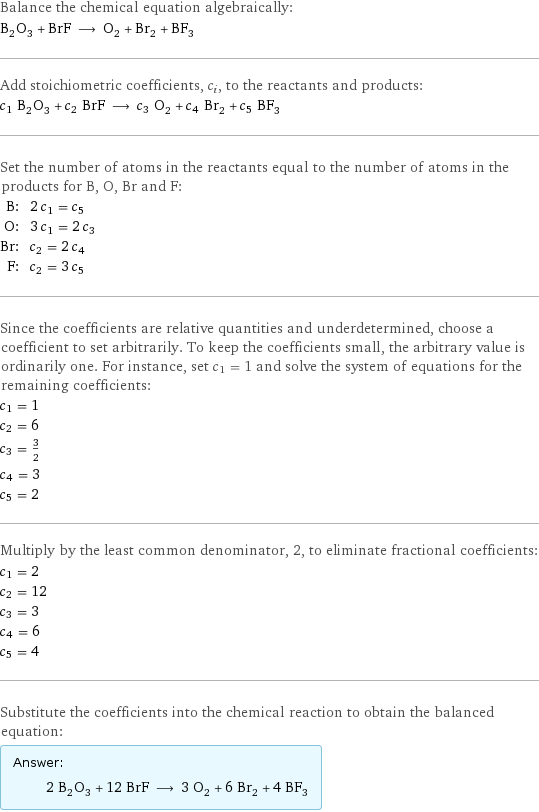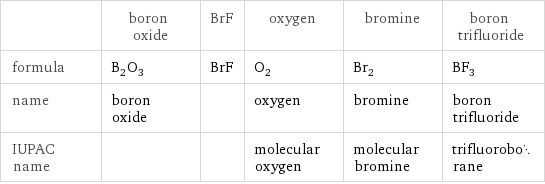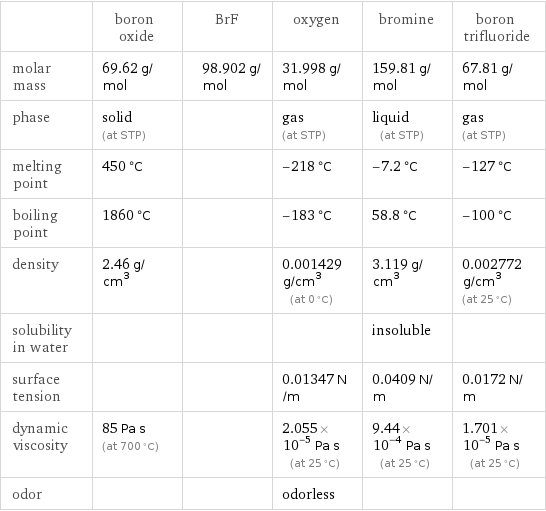Input interpretation

B_2O_3 boron oxide + BrF ⟶ O_2 oxygen + Br_2 bromine + BF_3 boron trifluoride
Balanced equation

Balance the chemical equation algebraically: B_2O_3 + BrF ⟶ O_2 + Br_2 + BF_3 Add stoichiometric coefficients, c_i, to the reactants and products: c_1 B_2O_3 + c_2 BrF ⟶ c_3 O_2 + c_4 Br_2 + c_5 BF_3 Set the number of atoms in the reactants equal to the number of atoms in the products for B, O, Br and F: B: | 2 c_1 = c_5 O: | 3 c_1 = 2 c_3 Br: | c_2 = 2 c_4 F: | c_2 = 3 c_5 Since the coefficients are relative quantities and underdetermined, choose a coefficient to set arbitrarily. To keep the coefficients small, the arbitrary value is ordinarily one. For instance, set c_1 = 1 and solve the system of equations for the remaining coefficients: c_1 = 1 c_2 = 6 c_3 = 3/2 c_4 = 3 c_5 = 2 Multiply by the least common denominator, 2, to eliminate fractional coefficients: c_1 = 2 c_2 = 12 c_3 = 3 c_4 = 6 c_5 = 4 Substitute the coefficients into the chemical reaction to obtain the balanced equation: Answer: | | 2 B_2O_3 + 12 BrF ⟶ 3 O_2 + 6 Br_2 + 4 BF_3
Structures

+ BrF ⟶ + +
Names

boron oxide + BrF ⟶ oxygen + bromine + boron trifluoride
Equilibrium constant
![Construct the equilibrium constant, K, expression for: B_2O_3 + BrF ⟶ O_2 + Br_2 + BF_3 Plan: • Balance the chemical equation. • Determine the stoichiometric numbers. • Assemble the activity expression for each chemical species. • Use the activity expressions to build the equilibrium constant expression. Write the balanced chemical equation: 2 B_2O_3 + 12 BrF ⟶ 3 O_2 + 6 Br_2 + 4 BF_3 Assign stoichiometric numbers, ν_i, using the stoichiometric coefficients, c_i, from the balanced chemical equation in the following manner: ν_i = -c_i for reactants and ν_i = c_i for products: chemical species | c_i | ν_i B_2O_3 | 2 | -2 BrF | 12 | -12 O_2 | 3 | 3 Br_2 | 6 | 6 BF_3 | 4 | 4 Assemble the activity expressions accounting for the state of matter and ν_i: chemical species | c_i | ν_i | activity expression B_2O_3 | 2 | -2 | ([B2O3])^(-2) BrF | 12 | -12 | ([BrF])^(-12) O_2 | 3 | 3 | ([O2])^3 Br_2 | 6 | 6 | ([Br2])^6 BF_3 | 4 | 4 | ([BF3])^4 The equilibrium constant symbol in the concentration basis is: K_c Mulitply the activity expressions to arrive at the K_c expression: Answer: | | K_c = ([B2O3])^(-2) ([BrF])^(-12) ([O2])^3 ([Br2])^6 ([BF3])^4 = (([O2])^3 ([Br2])^6 ([BF3])^4)/(([B2O3])^2 ([BrF])^12)](../image_source/b10b15a4f329d2cea9c2d4c23e40d5ec.png)
Construct the equilibrium constant, K, expression for: B_2O_3 + BrF ⟶ O_2 + Br_2 + BF_3 Plan: • Balance the chemical equation. • Determine the stoichiometric numbers. • Assemble the activity expression for each chemical species. • Use the activity expressions to build the equilibrium constant expression. Write the balanced chemical equation: 2 B_2O_3 + 12 BrF ⟶ 3 O_2 + 6 Br_2 + 4 BF_3 Assign stoichiometric numbers, ν_i, using the stoichiometric coefficients, c_i, from the balanced chemical equation in the following manner: ν_i = -c_i for reactants and ν_i = c_i for products: chemical species | c_i | ν_i B_2O_3 | 2 | -2 BrF | 12 | -12 O_2 | 3 | 3 Br_2 | 6 | 6 BF_3 | 4 | 4 Assemble the activity expressions accounting for the state of matter and ν_i: chemical species | c_i | ν_i | activity expression B_2O_3 | 2 | -2 | ([B2O3])^(-2) BrF | 12 | -12 | ([BrF])^(-12) O_2 | 3 | 3 | ([O2])^3 Br_2 | 6 | 6 | ([Br2])^6 BF_3 | 4 | 4 | ([BF3])^4 The equilibrium constant symbol in the concentration basis is: K_c Mulitply the activity expressions to arrive at the K_c expression: Answer: | | K_c = ([B2O3])^(-2) ([BrF])^(-12) ([O2])^3 ([Br2])^6 ([BF3])^4 = (([O2])^3 ([Br2])^6 ([BF3])^4)/(([B2O3])^2 ([BrF])^12)
Rate of reaction
![Construct the rate of reaction expression for: B_2O_3 + BrF ⟶ O_2 + Br_2 + BF_3 Plan: • Balance the chemical equation. • Determine the stoichiometric numbers. • Assemble the rate term for each chemical species. • Write the rate of reaction expression. Write the balanced chemical equation: 2 B_2O_3 + 12 BrF ⟶ 3 O_2 + 6 Br_2 + 4 BF_3 Assign stoichiometric numbers, ν_i, using the stoichiometric coefficients, c_i, from the balanced chemical equation in the following manner: ν_i = -c_i for reactants and ν_i = c_i for products: chemical species | c_i | ν_i B_2O_3 | 2 | -2 BrF | 12 | -12 O_2 | 3 | 3 Br_2 | 6 | 6 BF_3 | 4 | 4 The rate term for each chemical species, B_i, is 1/ν_i(Δ[B_i])/(Δt) where [B_i] is the amount concentration and t is time: chemical species | c_i | ν_i | rate term B_2O_3 | 2 | -2 | -1/2 (Δ[B2O3])/(Δt) BrF | 12 | -12 | -1/12 (Δ[BrF])/(Δt) O_2 | 3 | 3 | 1/3 (Δ[O2])/(Δt) Br_2 | 6 | 6 | 1/6 (Δ[Br2])/(Δt) BF_3 | 4 | 4 | 1/4 (Δ[BF3])/(Δt) (for infinitesimal rate of change, replace Δ with d) Set the rate terms equal to each other to arrive at the rate expression: Answer: | | rate = -1/2 (Δ[B2O3])/(Δt) = -1/12 (Δ[BrF])/(Δt) = 1/3 (Δ[O2])/(Δt) = 1/6 (Δ[Br2])/(Δt) = 1/4 (Δ[BF3])/(Δt) (assuming constant volume and no accumulation of intermediates or side products)](../image_source/0a561b579cbe4d7e8eeec12d28a61079.png)
Construct the rate of reaction expression for: B_2O_3 + BrF ⟶ O_2 + Br_2 + BF_3 Plan: • Balance the chemical equation. • Determine the stoichiometric numbers. • Assemble the rate term for each chemical species. • Write the rate of reaction expression. Write the balanced chemical equation: 2 B_2O_3 + 12 BrF ⟶ 3 O_2 + 6 Br_2 + 4 BF_3 Assign stoichiometric numbers, ν_i, using the stoichiometric coefficients, c_i, from the balanced chemical equation in the following manner: ν_i = -c_i for reactants and ν_i = c_i for products: chemical species | c_i | ν_i B_2O_3 | 2 | -2 BrF | 12 | -12 O_2 | 3 | 3 Br_2 | 6 | 6 BF_3 | 4 | 4 The rate term for each chemical species, B_i, is 1/ν_i(Δ[B_i])/(Δt) where [B_i] is the amount concentration and t is time: chemical species | c_i | ν_i | rate term B_2O_3 | 2 | -2 | -1/2 (Δ[B2O3])/(Δt) BrF | 12 | -12 | -1/12 (Δ[BrF])/(Δt) O_2 | 3 | 3 | 1/3 (Δ[O2])/(Δt) Br_2 | 6 | 6 | 1/6 (Δ[Br2])/(Δt) BF_3 | 4 | 4 | 1/4 (Δ[BF3])/(Δt) (for infinitesimal rate of change, replace Δ with d) Set the rate terms equal to each other to arrive at the rate expression: Answer: | | rate = -1/2 (Δ[B2O3])/(Δt) = -1/12 (Δ[BrF])/(Δt) = 1/3 (Δ[O2])/(Δt) = 1/6 (Δ[Br2])/(Δt) = 1/4 (Δ[BF3])/(Δt) (assuming constant volume and no accumulation of intermediates or side products)
Chemical names and formulas

| boron oxide | BrF | oxygen | bromine | boron trifluoride formula | B_2O_3 | BrF | O_2 | Br_2 | BF_3 name | boron oxide | | oxygen | bromine | boron trifluoride IUPAC name | | | molecular oxygen | molecular bromine | trifluoroborane
Substance properties

| boron oxide | BrF | oxygen | bromine | boron trifluoride molar mass | 69.62 g/mol | 98.902 g/mol | 31.998 g/mol | 159.81 g/mol | 67.81 g/mol phase | solid (at STP) | | gas (at STP) | liquid (at STP) | gas (at STP) melting point | 450 °C | | -218 °C | -7.2 °C | -127 °C boiling point | 1860 °C | | -183 °C | 58.8 °C | -100 °C density | 2.46 g/cm^3 | | 0.001429 g/cm^3 (at 0 °C) | 3.119 g/cm^3 | 0.002772 g/cm^3 (at 25 °C) solubility in water | | | | insoluble | surface tension | | | 0.01347 N/m | 0.0409 N/m | 0.0172 N/m dynamic viscosity | 85 Pa s (at 700 °C) | | 2.055×10^-5 Pa s (at 25 °C) | 9.44×10^-4 Pa s (at 25 °C) | 1.701×10^-5 Pa s (at 25 °C) odor | | | odorless | |
Units
